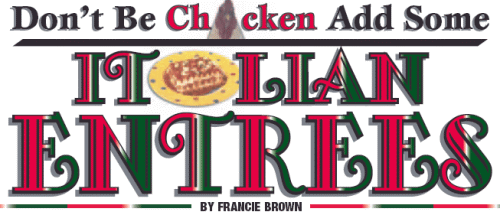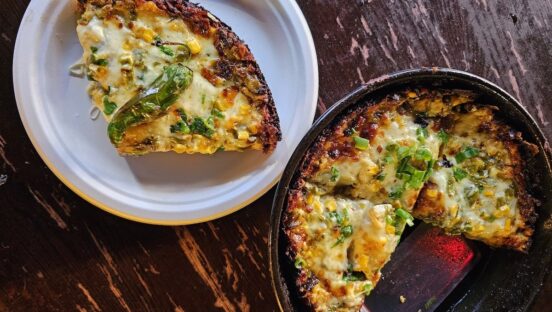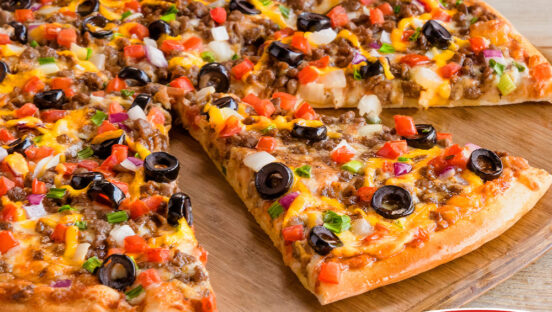
We here at PMQ hear it time and again: How do I add other meal options to my current menu? One thing that makes perfect sense to add to your menu is pasta.
For relatively inexpensively, you can add several pasta dishes, using your already existing supplies as toppings and sauces. Keep in mind, however, that while you may be able to use a lot of the same ingredients, every dish you add will probably need at least a few additional ingredients. See our previous Info Center on pastas at HERE.
Menu Placement
How do you know when adding additional entreacute;es, especially Italian entrées, is a good idea? Gregg Rapp, menu consultant, said that a good rule of thumb is to take a look at your competition. When you start losing customers to someplace else because you don't offer it, then it may be time to add it to your menu. "You make more money on Italian entreacute;es per person than pizzas," Gregg said. "When you sell a pizza for $12 that cost $2 to make and feeds four people, divided out, that isn't much profit per person. With Italian entreacute;es, you can sell it for more and make all of that profit from one person while his buddies order even more from you."
As far as menu placement goes, Gregg says that the best way to lay out your menu is with your most profitable menu items per person in the best position, which is the top, right corner of your menu. Describing the item in detail ensures that you will sell more of it. The more space on your menu you give an item, the more people see and want it.
Another thing to keep in mind is pricing. Figure out what your competition is charging for a particular item and how they handle the situation and then see about how much you can reasonably expect to charge.
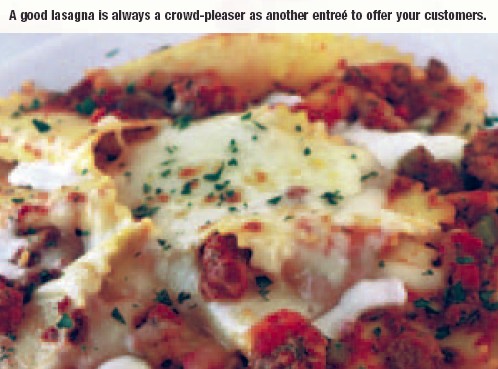
Parmesans
According to Joanne Fontanini of Fontanini Meats, chicken Parmesan is one of the easiest additions to a menu you can do. For their pizzeria, they buy fresh chicken breasts and cut them according to the menu item. "We do a lemon-herb breast and a chicken Parmesan, so as we're preparing them, we either marinate them in the lemon or as chicken parm," Joanne said. "Then we freeze them into individual portions and take out each day what we think we need and prepare it fresh that day."
Veal is a slightly different approach to menu additions. Veal can be substituted for chicken in many recipes and dishes. Francis Carrancejie of Berry Veal Corporation said that veal is easily and fairly inexpensively added to a pizzeria's existing menu. "Using a tenderized, prebreaded veal cutlet, you can cook it in any number of ways, including via fryer, flat grill or your oven," Francis said. "Expect to pay about $1.45 per portion on the cutlets." You also have the choice of ordering it in 10 or five pound boxes, depending on how much product you actually want.
Francis recommends slacking out the veal before you cook it. "Thawing the meat cuts down on the cooking time," Francis said. "It also ups the eye-appeal. Since it's prebreaded, the less time you spend cooking it, the prettier it is."
Cacciatore and Lasagna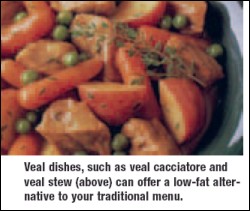
Cacciatore is another meal option using chicken or veal, green peppers, tomatoes, onions, mushrooms, herbs and sometimes wine, usually served on a bed of pasta. Cacciatore can be made at the beginning of the week and keeps a good three to five days, according to Francis. You can buy veal stew meat, which is a lean product and a bit more cost effective than the veal cutlets you might see on a veal Parmesan. For less than one dollar to you, you can offer your customer an entire plate of this meat. This kind of veal is best when used in a combination of other ingredients, such as veal cacciatore. See our recipe for this one in the PMQ Recipe Bank at www.pmq.com. A lasagna is a great thing to add to your menu. Using any of the meats you have for pizza, a bit of cheese and some pasta, you can quickly build lasagna. Sausage, ground beef, chicken and even veal are all great meats for a lasagna or you could even go the other way and add a vegetarian or spinach lasagna to your menu, using toppings from your supreme pizza. Lasagnas are easily precooked and frozen and keep for up to six weeks.
When looking to make and freeze lasagna, keep a few things in mind. You want to minimize the amount of moisture present both during the freezing and thawing processes in order to maintain a fresh taste and texture. The best way to do this when freezing is to make sure that the lasagna is fully cooled. Since most recipes recommend par baking the dish, cooling it completely before you freeze it keeps condensation from collecting while freezing. On the same note, when thawing it, leave it uncovered or only slightly covered to allow for the excess moisture to evaporate.
Something else to think about is that the frozen dishes (Parmesans, cacciatores and lasagnas) are all good ideas on a catering menu. It allows you to offer a wider range of selections as well as prepare something before the actual event.
Managing Shelf Life
Before you leap headfirst into offering something else, think about the amount of storage you have. While there hopefully won't be too many additions to your ingredients, there will inevitably be a few. According to Francis, the veal will last up to four months in the freezer and between three and five days pre-prepared, so you could make cacciatore and possibly a primavera early in the week when there isn't that much of a rush and then just heat up what you need for each meal, granted you have the storage space needed.
Joanne also said that one thing to keep in mind is to make sure that you have more than one application for everything that you add to your menu, in order to help control spoilage and food costs. "We have four different menu choices for chicken," Joanne said. "Chicken Parmesan, lemon-herb chicken, chicken marinara and a chicken barbeque pizza."
Frozen vs. Fresh menu options
Frozen versus fresh menu options should be carefully compared to choose the correct fit for your restaurant. "If your staff isn't very proficient in the kitchen, then pre-prepared food may be the way to go," Liz said. "If you have a highly trained chef and your customers are used to getting freshly prepared food at your restaurant, then fresh would be better."
A nice alternative to fresh or frozen is a combination of the two. Combine some pre-prepared ingredients with fresh, which gives the meal a prepared-on-premises taste and look. "There are more and more high quality, frozen entreeacute;s all the time," Liz said. "We've begun to expect that in our homes and the food service industry is looking to that kind of solution as well, because it's harder to find skilled help and in some ways, it may be a more cost-effective solution than to try to cook everything from scratch."
In all, in making a decision to add to your menu, take a look at your situation and at what your clientele expects. Examine your own situation, including your skills, your staff, your equipment, your ingredients, your storage space and what your clientele is looking for on the menu. Consider all of those and then start adding to your menu. It's a good way to increase your store sales and also to keep people coming back since you offer some variety and meet the needs of a broader set of consumers.

